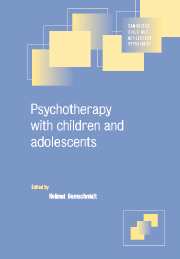Book contents
- Frontmatter
- Contents
- List of contributors
- Preface
- Part I Principles of psychotherapy with children, adolescents and families
- Part II Psychotherapeutic methods and settings
- 5 Psychodynamic therapy
- 6 Behaviour therapy
- 7 Cognitive behaviour therapy
- 8 Interpersonal psychotherapy for adolescents
- 9 Play therapy with children
- 10 Individual psychotherapy with adolescents
- 11 Group psychotherapy and psychodrama
- 12 Family therapy
- 13 Parent training
- 14 Combination of treatment methods
- Part III The practice of psychotherapy for specific disorders in childhood and adolescence
- Part IV The practice of psychotherapy in various settings
- Index
7 - Cognitive behaviour therapy
- Frontmatter
- Contents
- List of contributors
- Preface
- Part I Principles of psychotherapy with children, adolescents and families
- Part II Psychotherapeutic methods and settings
- 5 Psychodynamic therapy
- 6 Behaviour therapy
- 7 Cognitive behaviour therapy
- 8 Interpersonal psychotherapy for adolescents
- 9 Play therapy with children
- 10 Individual psychotherapy with adolescents
- 11 Group psychotherapy and psychodrama
- 12 Family therapy
- 13 Parent training
- 14 Combination of treatment methods
- Part III The practice of psychotherapy for specific disorders in childhood and adolescence
- Part IV The practice of psychotherapy in various settings
- Index
Summary
The cognitive behaviour therapies have been used in many different psychiatric disorders of children and adolescents. The management of many of these disorders is discussed in other parts of this book. The present chapter provides an overview of cognitive behavioural techniques that are used with young people, the kinds of disorders that they are most often used for, and the evidence for their effectiveness. Before reviewing these issues, however, it is necessary to consider briefly how cognitive behaviour therapy is defined.
Definition of cognitive behaviour therapy
Cognitive models of psychopathology view children and adolescents as actively involved in constructing their reality. Cognitive behaviour therapy (CBT) is therefore based on the assumption that psychopathology in young people is due, at least in part, to cognitive processing deficiences or deficits. A very wide variety of procedures has been included under the broad umbrella of the term ‘cognitive behaviour therapy’. At the core of most techniques is an emphasis on certain cognitive interventions, which are designed to produce changes in thinking. For most cognitive therapists these changes in thinking are hypothesized to lead to changes in behaviour, mood, or actions. Nevertheless, while recognizing the importance of cognitions and development of mental disorder among children and adolescents, cognitive behavioural formulations also emphasize the learning process, and the ways in which the child's family or environment can change both cognition and behaviour. Cognitive behaviour therapy for young people therefore usually has a significant emphasis on behavioural performance-based procedures. Indeed, in younger children, behavioural techniques form the core of the therapy, and there may be relatively little application of so-called cognitive techniques (see later).
- Type
- Chapter
- Information
- Psychotherapy with Children and Adolescents , pp. 113 - 123Publisher: Cambridge University PressPrint publication year: 2001



